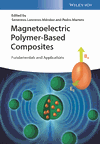Low-Dimensional Polymer-Based Magnetoelectric Structures
Summary
Polymer-based, low-scale magnetoelectric (ME) materials have been attracting increasing attention not only for novel phenomena associated with fundamental physics but also due to exciting application potential in micro- and nanoelectronic devices and in the biomedical field. Currently, most ME nanocomposite films and low-dimensional materials show quite low ME response compared with their laminated counterparts. New material designs, effects, and fabrication processes are required to grow ME nanocomposites with controlled composition, structure, interface, and suitable ME response. ME ceramic spheres are the most studied ones due to their high ME coefficient of the ceramics compared with polymer-based composites. Furthermore, polymer-basedME spheres will allow new application areas such as biomaterials for cell culture and drug delivery. With respect to polymer-based materials, ME composites composed of CFO nanoparticles in a poly(vinylidene fluoride) (PVDF) polymer-fiber matrix have been prepared by electro-spinning.



